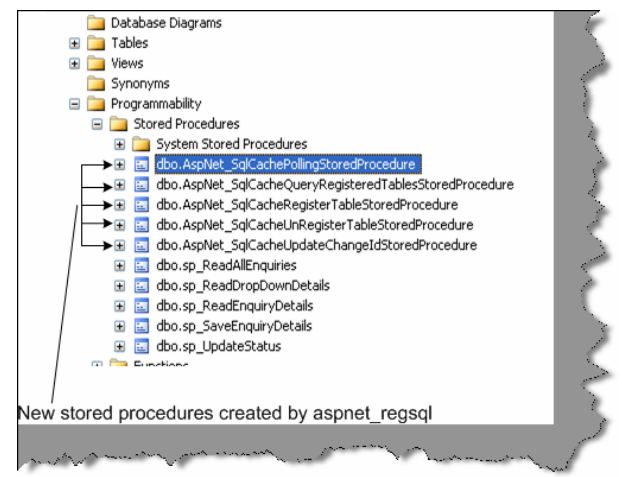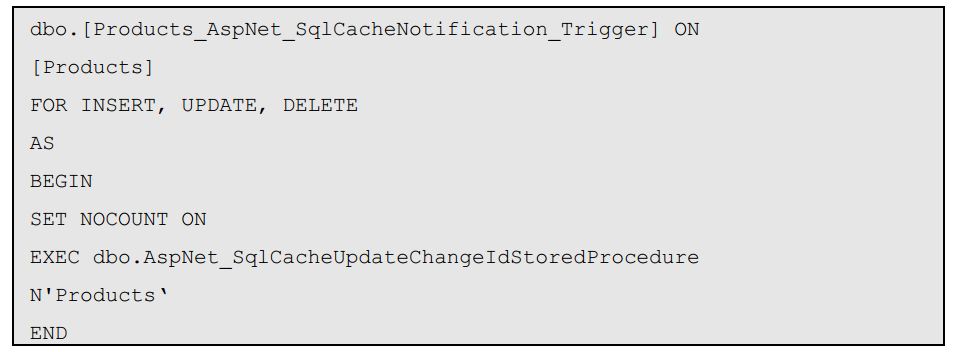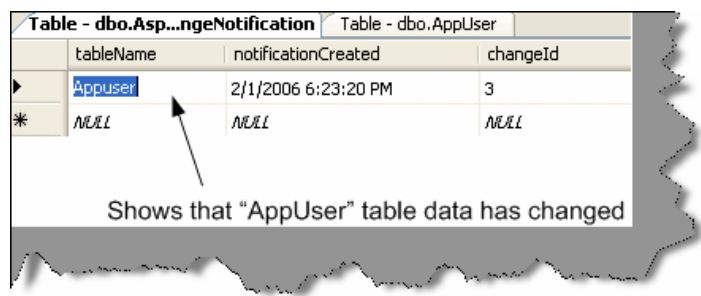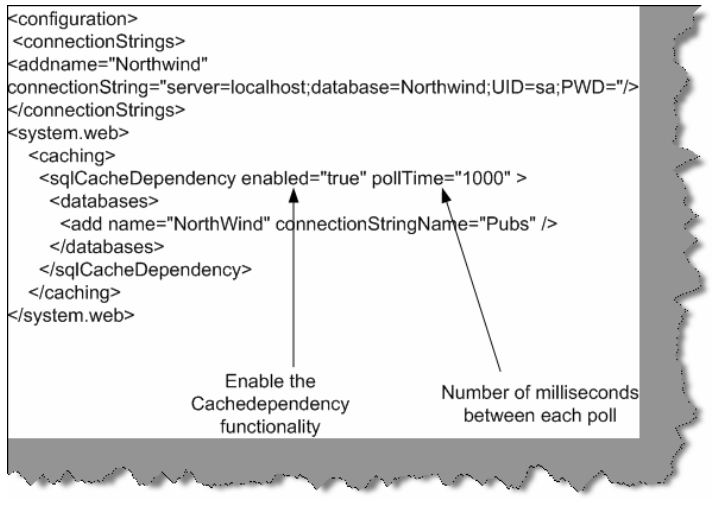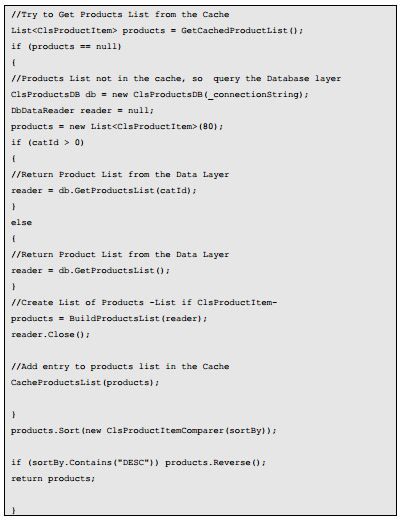Interview Questions Answers Microsoft Net Caching ASP DOT Net
What is an application object?
Application object can be used in situation where we want data to be shared across users globally.
what is the difference between Cache object and application object?
The main difference between the Cache and Application objects is that the Cache object provides cache-specific features, such as dependencies and expiration policies.
How can get access to cache object?
The Cache object is defined in the ‘System.Web.Caching’ namespace. You can get a reference to the Cache object by using the Cache property of the HttpContext class in the ‘System.Web’ namespace or by using the Cache property of the Page object.
What are dependencies in cache and types of dependencies?
When you add an item to the cache, you can define dependency relationships that can force that item to be removed from the cache under specific activities of dependencies. Example if the cache object is dependent on file and when the file data changes you want the cache object to be update. Following are the supported dependency:-
• File dependency: – Allows you to invalidate a specific cache item when a disk based file or files change.
• Time-based expiration: – Allows you to invalidate a specific cache item depending on predefined time.
• Key dependency:- Allows you to invalidate a specific cache item depending when another cached item changes.
Can you show a simple code showing file dependency in cache?
Partial Class Default_aspx
Public Sub displayAnnouncement()
Dim announcement As String
If Cache(“announcement”) Is Nothing Then
Dim file As New _
System.IO.StreamReader _
(Server.MapPath(“announcement.txt”))
announcement = file.ReadToEnd
file.Close()
Dim depends As New _
System.Web.Caching.CacheDependency _
(Server.MapPath(“announcement.txt”))
Cache.Insert(“announcement”, announcement, depends)
End If
Response.Write(CType(Cache(“announcement”), String))
End Sub
Private Sub Page_Init(ByVal sender As Object, ByVal e As
System.EventArgs) Handles Me.Init
displayAnnouncement()
End Sub
End Class
Above given method displayAnnouncement() displays banner text from Announcement.txt file which is lying in application path of the web directory. Above method, first checks whether the Cache object is nothing, if the cache object is nothing then it moves further to load the cache data from the file. Whenever the file data changes the cache object is removed and set to nothing.
What is Cache Callback in Cache?
Cache object is dependent on its dependencies example file based, time based etc. Cache items remove the object when cache dependencies change.ASP.NET provides capability to execute a callback method when that item is removed from cache.
What is scavenging?
When server running your ASP.NET application runs low on memory resources, items are removed from cache depending on cache item priority. Cache item priority is set when you add item to cache. By setting the cache item priority controls, the items scavenging are removed according to priority.
What are different types of caching using cache object of ASP.NET?
You can use two types of output caching to cache information that is to be transmitted to and displayed in a Web browser:
- Page Output Caching: Page output caching adds the response of page to cache object. Later when page is requested page is displayed from cache rather than creating the page object and displaying it. Page output caching is good if the site is fairly static.
- Page Fragment Caching: If parts of the page are changing, you can wrap the static sections as user controls and cache the user controls using page fragment caching.
How can you cache different version of same page using ASP.NET cache object?
Output cache functionality is achieved by using “OutputCache” attribute on ASP.NET page header. Below is the syntax
- VaryByParam: – Caches different version depending on input parameters send through HTTP POST/GET.
- VaryByHeader: – Caches different version depending on the contents of the page header.
- VaryByCustom: –Lets you customize the way the cache handles page variations by declaring the attribute and overriding the GetVaryByCustomString handler.
- VaryByControl: –Caches different versions of a user control based on the value of properties of ASP objects in the control.
How will implement Page Fragment Caching?
Page fragment caching involves the caching of a fragment of the page, rather than the entire page. When portions of the page are need to be dynamically created for each user request this is best method as compared to page caching. You can wrap Web Forms user control and cache the control so that these portions of the page do not need to be recreated each time.
Can you compare ASP.NET sessions with classic ASP?
ASP.NET session caches per user session state. It basically uses “HttpSessionState” class. Following are the limitations in classic ASP sessions:-
- ASP session state is dependent on IIS process very heavily. So if IIS restarts ASP session variables are also recycled.ASP.NET session can be independent of the hosting environment thus ASP.NET session can be maintained even if IIS reboots.
- ASP session state has no inherent solution to work with Web Farms.ASP.NET session can be stored in state server and SQL SERVER which can support multiple server.
- ASP session only functions when browser supports cookies.ASP.NET session can be used with browser side cookies or independent of it.
Which are the various modes of storing ASP.NET session?
- InProc: – In this mode Session, state is stored in the memory space of the Aspnet_wp.exe process. This is the default setting. If the IIS reboots or web application restarts then session state is lost.
- StateServer:-In this mode Session state is serialized and stored in a separate process (Aspnet_state.exe); therefore, the state can be stored on a separate computer(a state server).
- SQL SERVER: – In this mode Session, state is serialized and stored in a SQL Server database.
Session state can be specified in <sessionState> element of application configuration file. Using State Server and SQL SERVER session state can be shared across web farms but note this comes at speed cost as ASP.NET needs to serialize and deserialize data over network repeatedly.
Is Session_End event supported in all session modes?
Session_End event occurs only in “Inproc mode”. “State Server” and “SQL SERVER” do not have Session_End event.
What are the steps to configure StateServer Mode?
Following are the things to remember so that StateServer Mode works properly:-
- StateServer mode session data is stored in a different process so you must ensure that your objects are serializable.
- <machineKey> elements in Web.config should be identical across all servers. So this ensures that encryption format is same across all computers.
- IIS metabase (\LM\W3SVC\2) must be identical across all servers in that farm.
What are the steps to configure SQLServer mode?
Following are the things to remember so that SQLSERVER Mode works properly:-
- SQLSERVER mode session data is stored in a different process so you must ensure that your objects are serializable.
- IIS metabase (\LM\W3SVC\2) must be identical across all servers in that farm.
- By default Session objects are stored in “Tempdb”, you can configure it store outside “TempDB” by running Microsoft provided SQL script.
Where do you specify session state mode in ASP.NET?
What are the other ways you can maintain state?
Other than session variables, you can use the following technique to store state:
- Hidden fields
- View state
- Hidden frames
- Cookies
- Query strings
What are benefits and Limitation of using Hidden fields?
Following are the benefits of using Hidden fields:-
- They are simple to implement.
- As data is cached on client side, they work with Web Farms.
- All browsers support hidden field.
- No server resources are required.
Following are limitations of Hidden field:-
- They can be tampered creating a security hole.
- Page performance decreases if you store large data, as the data are stored in pages itself.
- Hidden fields do not support rich structures as HTML hidden fields are only single valued. Then you have to work around with delimiters etc to handle complex structures. Below is how you will actually implement hidden field in a project
What is ViewState?
Viewstate is a built-in structure for automatically retaining values amongst the multiple requests for the same page. The viewstate is internally maintained as a hidden field on the page but is hashed, providing greater security than developer-implemented hidden fields do.
Does the performance for viewstate vary according to User controls?
Performance of viewstate varies depending on the type of server control to which it is applied. Label, TextBox, CheckBox, RadioButton, and HyperLink are server controls that perform well with ViewState. DropDownList, ListBox, DataGrid, and DataList suffer from poor performance because of their size and the large amounts of data making roundtrips to the server.
What are benefits and Limitation of using Viewstate for state management?
Following are the benefits of using Viewstate:-
- No server resources are required because state is in a structure in the page code.
- Simplicity.
- States are retained automatically.
- The values in view state are hashed, compressed, and encoded, thus representing a higher state of security than hidden fields.
- View state is good for caching data in Web frame configurations because the data is cached on the client.
Following are limitation of using Viewstate:-
- Page loading and posting performance decreases when large values are stored because view state is stored in the page.
- Although view state stores data in a hashed format, it can still be tampered because it is stored in a hidden field on the page. The information in the hidden field can also be seen if the page output source is viewed directly, creating a potential security risk.
Below is sample of storing values in view state.
this.ViewState[“EnterTime”] = DateTime.Now.ToString();
How can you use Hidden frames to cache client data ?
This technique is implemented by creating a Hidden frame in page which will contain your data to be cached.
Above is a sample of hidden frames where the first frame “data_of_frame1.html” is visible and the remaining frames are hidden by giving whole col section to first frame. 100 % is allocated to first frame and remaining frames thus remain hidden.
What are benefits and limitations of using Hidden frames?
Following are the benefits of using hidden frames:
- You can cache more than one data field.
- The ability to cache and access data items stored in different hidden forms.
- The ability to access JScript® variable values stored in different frames if they come from the same site.
The limitations of using hidden frames are:
- Hidden frames are not supported on all browsers.
- Hidden frames data can be tampered thus creating security hole.
What are benefits and limitations of using Cookies?
Following are benefits of using cookies for state management:-
- No server resources are required as they are stored in client.
- They are light weight and simple to use
Following are limitation of using cookies:-
- Most browsers place a 4096-byte limit on the size of a cookie, although support for 8192- byte cookies is becoming more common in the new browser and client-device versions available today.
- Some users disable their browser or client device’s ability to receive cookies, thereby limiting the use of cookies.
- Cookies can be tampered and thus creating a security hole.
- Cookies can expire thus leading to inconsistency.
Below is sample code of implementing cookies
What is Query String and What are benefits and limitations of using Query Strings?
A query string is information sent to the server appended to the end of a page URL.
Following are the benefits of using query string for state management:-
- No server resources are required. The query string containing in the HTTP requests for a specific URL.
- All browsers support query strings.
Following are limitations of query string:-
- Query string data is directly visible to user thus leading to security problems.-
- Most browsers and client devices impose a 255-character limit on URL length.
Below is a sample “Login” query string passed in URL
http://www.querystring.com/login.asp?login=testing.
This query string data can then be requested later by using Request.QueryString(“login”).
What is Absolute and Sliding expiration?
Absolute Expiration allows you to specify the duration of the cache, starting from the time the cache is activated. The following example shows that the cache has a cache dependency specified, as well as an expiration time of one minute.
Sliding Expiration specifies that the cache will expire if a request is not made within a specified duration. Sliding expiration policy is useful whenever you have a large number of items that need to be cached, because this policy enables you to keep only the most frequently accessed items in memory. For example, the following code specifies that the cache will have a sliding duration of one minute. If a request is made 59 seconds after the cache is accessed, the validity of the cache would be reset to another minute:
What is cross page posting?
By default, button controls in ASP.NET pages post back to the same page that contains the button, where you can write an event handler for the post. In most cases this is the desired behavior, but occasionaly you will also want to be able to post to another page in your application. The Server.Transfer method can be used to move between pages, however the URL does not change. Instead, the cross page-posting feature in ASP.NET 2.0 allows you to fire a normal post back to a different page in the application. In the target page, you can then access the values of server controls in the source page that initiated the post back.
To use cross page posting, you can set the PostBackUrl property of a Button, LinkButton or ImageButton control, which specifies the target page. In the target page, you can then access the PreviousPage property to retrieve values from the source page. By default, the PreviousPage property is of type Page, so you must access controls using the FindControl method. You can also enable strongly-typed access to the source page by setting the PreviousPageType directive in the target page to the virtual path or Type name of the source page. Here is a systematic guide for implementing the cross-page post back using controls that implement the IButtonControl interface.
- Create a Web Form and insert a Button control on it using the VS .NET designer.
- Set the button’s PostBackUrl property to the Web Form you want to post back. For instance in this case it is “nextpage.aspx”

When the PostBackUrl property of the IButtonControl is set, the ASP.NET framework binds the corresponding HTML element to new JavaScript function named WebForm_DoPostBackWithOptions. The corresponding HTML rendered by the ASP.NET 2.0 will look like this:
How do we access viewstate value of this page in the next page ?
View state is page specific; it contains information about controls embedded on the particular page. ASP.NET 2.0 resolves this by embedding a hidden input field name, __POSTBACK. This field is embedded only when there is an IButtonControl on the page and its PostBackUrl property is set to a non-null value. This field contains the view state information of the poster page. To access the view state of the poster page, you can use the new PreviousPage property of the page:
Then you can find any control from the previous page and read its state:
This cross-page post back feature also solves the problem of posting a Form to multiple pages, because each control, in theory, can point to different post back URL.
Can we post and access view state in another application?
You can post back to any page and pages in another application, too. However, if you are posting pages to another application, the PreviousPage property will return null. This is a significant restriction, as it means that if you want to use the view state, you are confined, for example, posting to pages in the same virtual directory. Even so, this is a highly acceptable addition to the functionality of ASP.NET.
What is SQL Cache Dependency in ASP.NET 2.0?
SQL cache dependencies is a new feature in ASP.NET 2.0 which can automatically invalidate a cached data object (such as a Dataset) when the related data is modified in the database. So for instance if you have a dataset, which is tied up to, a database tables any changes in the database table will invalidate the cached data object which can be a dataset or a data source.
How do we enable SQL Cache Dependency in ASP.NET 2.0?
Below are the broader steps to enable a SQL Cache Dependency:-
- Enable notifications for the database.
- Enable notifications for individual tables.
- Enable ASP.NET polling using “web.config” file
- Finally use the Cache dependency object in your ASP.NET code
Enable notifications for the database.
Before you can use SQL Server cache invalidation, you need to enable notifications for the database. This task is performed with the aspnet_regsql.exe command-line utility, which is located in the c:\[WinDir]\Microsoft.NET\Framework\[Version] directory.
So now, let us try to understand what happens in the database because of “aspnet_regsql.exe”. After we execute the “aspnet_regsql -ed -E -d Northwind” command you will see one new table and four new stored procedures created.
Essentially, when a change takes place, a record is written in this table. The SQL Server polling queries this table for changes.
Just to make brief run of what the stored procedures do.
“AspNet_SqlCacheRegisterTableStoredProcedure” :- This stored procedure sets a table to support notifications. This process works by adding a notification trigger to the table, which will fire when any row is inserted, deleted, or updated.
“AspNet_SqlCacheUnRegisterTableStoredProcedure”:- This stored procedure takes a registered table and removes the notification trigger so that notifications won’t be generated.
“AspNet_SqlCacheUpdateChangeIdStoredProcedure”:- The notification trigger calls this stored procedure to update the AspNet_SqlCacheTablesForChangeNotification table, thereby indicating that the table has changed.
AspNet_SqlCacheQueryRegisteredTablesStoredProcedure:- This extracts just the table names from the AspNet_SqlCacheTablesForChangeNotification table. It is used to get a quick look at all the registered tables.
AspNet_SqlCachePollingStoredProcedure:- This will get the list of changes from the aspNet_SqlCacheTablesForChangeNotification table. It is used to perform polling.
Enabling notification for individual tables
Once the necessary stored procedure and tables are created then we have to notify saying which table needs to be enabled for notifications. That can be achieved by two ways:-
- aspnet_regsql -et -E -d Northwind -t Products
- Exec spNet_SqlCacheRegisterTableStoredProcedure ‘TableName’
Registering tables for notification internally creates triggerfor the tables. For instance, for a “products” table the following trigger is created. So any modifications done to the “Products” table will update the ‘AspNet_SqlCacheNotification’ table.
CREATE TRIGGER
“AspNet_SqlCacheTablesForChangeNotification” contains a single record for every table you’re monitoring. When you make a change in the table (such as inserting, deleting or updating a record), the change Id column is incremented by 1.ASP.NET queries this table repeatedly keeps track of the most recent changed values for every table. When this value changes in a subsequent read, ASP.NET knows that the table has changed.
Enable ASP.NET polling using “web.config” file Now that all our database side is configured in order to get the SQL Cache working in the ASP.NET side we need to do some configuration in the web.config file. We need to set two attributes in the “web.config” file:-
- Set “Enabled” attribute to true to set the caching on.
- Set the poll time attribute to the number of milliseconds between each poll
Below is the snapshot of the web.config file.
Finally use the Cache dependency object in your ASP.NET code Now comes the final step to use our cache dependency with programmatic data caching, a data source control, and output caching.
For programmatic data caching, we need to create a new SqlCacheDependency and supply that to the Cache.Insert() method. In the SqlCacheDependency constructor, you supply two strings. The first is the name of the database you defined in the element in the section of the web.config file e.g: Northwind. The second is the name of the linked table e.g: Products.
ClsProductItem is business class, and here we are trying to cache a list of ClsProductItem instead of DataSet or DataTable.
The following method is used by an ObjectDataSource Control to retrieve List of Products
To perform the same trick with output caching, you simply need to set the SqlDependency property with the database dependency name and the table name, separated by a colon:








